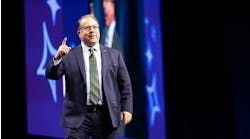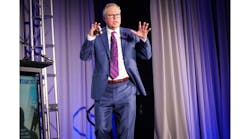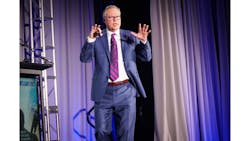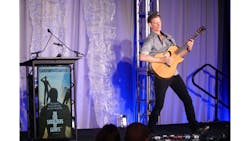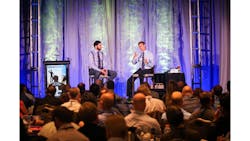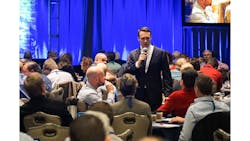HOUSTON — Nexstar Network held its annual spring meeting March 16-17, 2017, with the theme of “On the Shoulders of Giants.” Becoming a giant of a leader requires vision, financial stability, good health, reach and influence, and a knowledge of what your services are worth. Leadership Spotlight 2017 (formerly known as Owners Spotlight) focused on executive management topics ranging from the professional to the personal for more than 280 Nexstar members who attended the meeting.
Setting the vision
Nexstar President and CEO Jack Tester opened the meeting with the definition of a giant: when you are a leader who has developed a leader, and so on. But it’s not just that fact which makes someone an extraordinary leader.
“I think we confuse leadership with independence; we all talk about how we want to set a course for our life and bravely march toward that — being independent isn't that hard, but being a great leader is hard,” Tester said. “The hard work of leadership happens when there is no script, when people are judging your actions every minute of every day.”
He noted that Nexstar founder Frank Blau was extraordinary because of his “why” — he wanted to educate other contractors on the business breakthroughs he had made. Tester went on to discuss the critical importance of having a “why” for what you do for a living. It can and will change over time, but without it you’re only doing an average or less-than-average job. A why can be anything from wanting to provide for your family to wanting to leave a legacy.
“Your why is your fuel; it gives you strength when you’re tired,” Tester said. “It’s the energy of leadership.”
Leaders should not expect their team members to work toward the leader’s why — they don’t identify with it. A person must come up with their own why. It is not a leader’s job to tell employees what their own purpose, or why, is, but it is a leader’s job to help them find this out for themselves.
Tester was followed by guitar virtuoso Mike Rayburn, who has played venues all over the world, from city bars to Carnegie Hall. He asked Nexstar members to consider the question, “What if?”
“When you ask yourself, ‘What if?’ you’re not running around looking for reasons you can’t, by default,” Rayburn said. “Be the ones who step outside the curve, rather than follow it. Create change in your business rather than manage it.”
Asking “what if” helps a person get to their sense of purpose, or their why, Rayburn said.
Nexstar Director of Training Keith Mercurio, who facilitated Leadership Spotlight, then led members in an exercise to identify limiting beliefs they have about themselves. For example, one member volunteered to the group that an underlying limiting belief he had about being a technician was keeping him from selling the career to prospective employees. Members replaced these limiting beliefs with new, empowered beliefs.
Stability: Financial and health
Matt Garrett, founder of San Diego-based TGG Accounting, brought members through key elements of financial planning that would help them achieve financial stability. He encouraged members to find a financial planner who will work for an hourly rate vs. commission, who will disclose commissions and show how much they make for each product they offer, and who will start the initial meeting by asking, “What are your goals?”
Dr. Jami Rassmussen, founder of Health Path Chiropractic in Lino Lakes, Minn., followed Garrett to discuss stability in health. Commenting on the age-old phrase, “At least you have your health,” Rassmussen asked the audience, “Is health something you have, or is it something you have to work toward constantly?” Because it is the latter, Rassmussen introduced Nexstar members to his five pillars of health: eat well, move well, think well, sleep well and adapt well. He shared key strategies for improving each of these.
Reach and influence
Business growth expert John Milos kicked off day two by telling his story of business success through three key concepts: vision and mission, process and culture. Using these concepts, he grew his former truck accessories company, Stylin’ Concepts, 933 percent from the time he bought it to when he sold it. He drew parallels between the auto-parts industry and the trades, saying that one of the main similarities was the fact that customers don’t really want you — they’re calling because you can potentially solve their problem. He asked members to truly know what it is they do.
“Every single member of your team should know what your vision is and be able to describe it to anyone who may ask,” Milos said. “Your vision statement should be simple and clear.”
Milos went on to talk about the importance of procedure. At Stylin’ Concepts, they even had a produce for how to use toilet paper. He cited McDonald’s as an exemplar for procedure.
“Structure allows vision to unfold,” Milos said. “Procedure allows average people to deliver consistent, excellent results. It’s like driving a car: First, you have two hands on the wheel and you’re doing everything very carefully. Eventually, when you’ve been doing it awhile, you’ve got one hand on the wheel and your other arm draped out the window.”
In regard to culture, Milos stressed the fact that leaders cannot change the culture of their company on their own. They can create the environment for the culture they want, but then must get the best people for that environment. They also can help draw out the best in the people they have. One thing, he said, is toxic for any work culture: whining.
“It’s each employee’s job to stop it when it happens,” he said.
Pricing power
Philip Daus, a partner at global pricing consultancy Simon-Kucher & Partners, built the idea of “pricing power” for members. It is calculated by taking the difference between your goal for the last price increase at your company and the realized price increase. Companies that have pricing power have 33-percent higher profits, he said.
Daus told the residential contractors in the room that something as simple as not rounding your prices and discounts can bring up your profits. He encouraged them to analyze their sales team’s sales contributions vs. profit contributions. Even if a contractor’s sales teams are working on commission, objectives in the company may not be aligned. A top salesperson could be giving steep discounts in order to make the sales, thus driving down profit margins.
Building a giant
Mercurio closed the Leadership Spotlight by leading the Nexstar members in a building block exercise. Each table had a bag full of wooden blocks. The members wrote on the blocks with Sharpie pens, starting with their “whys” at the bottom of the structure, and building up through their goals in stability, reach, influence and pricing. At the top of the structure, they were asked to place blocks with the names of people they hope to lift up as a result of their goals.
“What happens to your why when it’s removed from the structure?” Mercurio said. “Your why is the reason for everything you do.”
